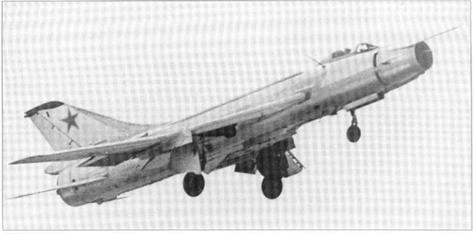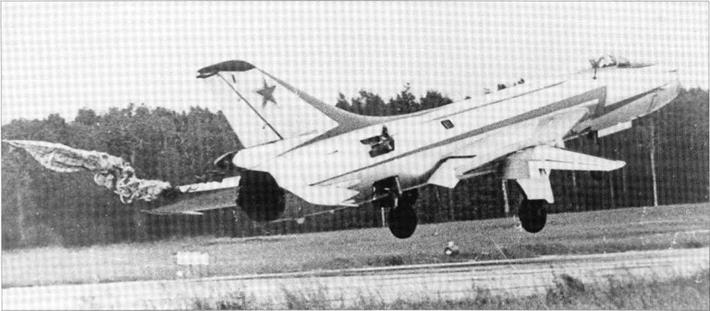Sukhoi S-22I
Purpose: To modify a tactical fighter to have a variable-sweep wing.
Design Bureau: OKB-51 of P O Sukhoi, Moscow.
Spurred by the USAF/USN TFX programme, Sukhoi (and later Mikoyan) researched aircraft with variable sweepback, also called VG, variable-geometry, ‘swing wings’. Extensive model testing began at CAHI (TsAGI) in 1963. In early 1965 Sukhoi OKB Deputy N G Zyrin was appointed Chief Designer of the project, with V Krylov team leader. To test full-scale wings the OKB-51 factory selected a production Su-7BM which it had already been using for a year to test other advances. L Moi – seyshchikov was appointed chief flight-test engineer. Modification of the aircraft took place in January-July 1966, and Vladimir Ilyushin made the first flight on 2nd August 1966. Later LII pilots evaluated the aircraft, and on 9th July 1967 OKB pilot Evgeny Kuku – shev flew it publicly at the Domodyedovo air display. Testing was completed at the end of
1967, and though this was clearly an interim aircraft the Council of Ministers decreed that series production should begin in 1969. Unexpectedly, derived versions remained in production to 1991, over 2,000 being delivered.
It was by no means certain that an existing wing could be modified with variable sweep – back. The problem was to minimise weight growth whilst at the same time almost eliminating longitudinal shift in centre of pressure (wing lift) and centre of gravity. The original wing had the considerable leading-edge angle of 63°, matched to the supersonic maximum speed attainable. The intention was to enable the wing to pivot forward, to increase span and lift at low speeds. Doing so would naturally move the centre of pressure forwards, and at the same time it would also move the centre of gravity forwards. The objective was to make these cancel out. This was achieved by pivoting only the outer 4.5m (14ft 9in), placing the pivots close behind the main landing gear in a region well able to diffuse the concentrated loads into the struc
ture. Each outer panel was driven hydraulically forward to a minimum sweep of 30°. Following tunnel testing of models, three sections of slat were added over almost the whole span of each pivoted leading edge. Inboard of the pivot the existing fence was made deeper and extended under the leading edge to serve as a stores pylon (plumbed for a tank). Among structural changes, the upper and lower skins were each reinforced between the fence and flap by pairs of axial stiffeners (thus, eight in all).
Though empty weight was increased from 8,410kg (18,541 Ib) to the figure given below, and internal fuel was reduced by 404 litres (89 Imperial gallons), flying at 30° sweep extended both range and endurance, and enabled much heavier external loads to be lifted from short fields. Pilots reported very favourably on all aspects of handling, except for the fact that at extreme angles of attack there was no stallwarning buffet.
|
Span (63°) |
10.03m |
32 ft 10% in |
|
(30°) |
13.68m |
44ftl03/4in |
|
Length overall |
1 9.03 m |
62 ft 5!4 in |
|
Wing area (63°) |
34.45m2 |
370.8ft2 |
|
(30°) |
38.49m2 |
414.3ft2 |
|
Dimensions |
![]()

|











